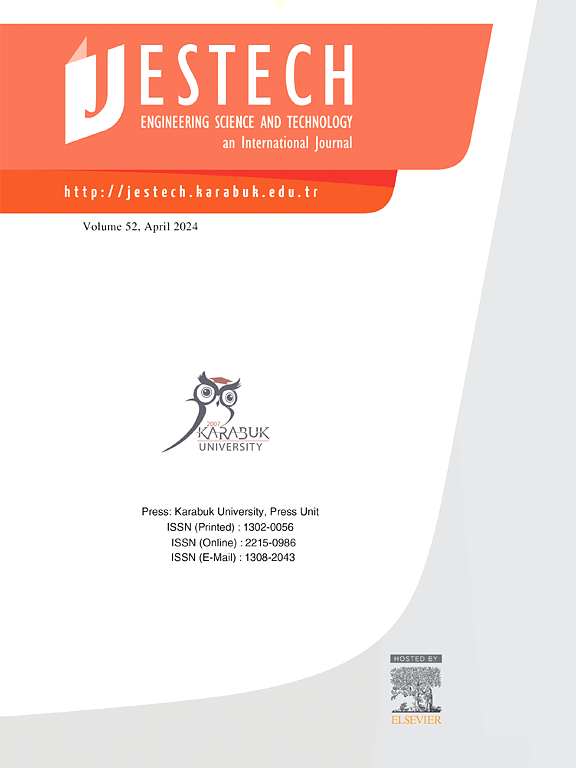Polarization-independent high-sensitive metamaterial sensor for chemical sensing and EMI shielding application
IF 5.1
2区 工程技术
Q1 ENGINEERING, MULTIDISCIPLINARY
Engineering Science and Technology-An International Journal-Jestech
Pub Date : 2025-02-01
DOI:10.1016/j.jestch.2025.101952
引用次数: 0
Abstract
Chemical sensing is essential for characterizing liquid chemical samples in the chemical industry. Consequently, Electromagnetic interference (EMI) shielding is crucial for promising the reliable functioning of diverse electronic devices. This study proposes a polarization-independent high-sensitive quadrant-shaped metamaterial (QM) sensor for chemical sensing and effective electromagnetic interference (EMI) shielding applications. The metamaterial (MTM) is specifically developed to demonstrate a polarization-insensitive electromagnetic (EM) response, which has a high sensitivity level for chemical sensing. This study explores the EMI shielding and sensor performance using a 0.33λ × 0.33λ × 0.052λ mm3 Rogers RT5880 substrate. This MTM-based sensor exhibits resonance at 10 GHz for both transverse electric (TE) and transverse magnetic (TM) modes. Besides, the transmission coefficient(S21) is investigated at different φ-angle and θ-angle, where φ-angle and θ-angle are applied up to 90˚ and 75˚ for TE and TM modes. Furthermore, To validate the designed MTM, a 40 × 50 mm2 array prototype is fabricated, and the performance of the MTM is investigated in the laboratory, where the real-time investigation results strongly agree with the simulation result. Besides, the unit cell structure can be utilized as a sensor for detecting different liquid chemical substances. The sensor model achieves a high sensitivity of 18.87 as well as a high-quality Factor (Q-Factor) of 475. The MTM sensor also has a significant Figure of Merit (FoM) of 4411.80, which is a significant achievement for sensing technology. Therefore, The proposed compact and polarization-insensitive MTM has possibilities in various sensing industries, including telecommunications and liquid chemical substance monitoring, and it shows promise for improvements in chemical industries and EMI shielding technologies.
用于化学传感和电磁干扰屏蔽的非极化高灵敏度超材料传感器
在化学工业中,化学传感是表征液体化学样品的关键。因此,电磁干扰(EMI)屏蔽对于保证各种电子设备的可靠运行至关重要。本研究提出了一种偏振无关的高灵敏度象限形超材料(QM)传感器,用于化学传感和有效的电磁干扰(EMI)屏蔽。超材料(MTM)是专门开发的,以证明极化不敏感的电磁(EM)响应,它具有高灵敏度水平的化学传感。本研究采用0.33λ × 0.33λ × 0.052λ mm3 Rogers RT5880衬底,探讨了电磁干扰屏蔽和传感器性能。这种基于mtm的传感器在10 GHz下显示出横向电(TE)和横向磁(TM)模式的共振。此外,研究了不同φ角和θ角下的透射系数S21,其中TE和TM模式的φ角和θ角分别为90˚和75˚。为了验证所设计的MTM,制作了一个40 × 50 mm2阵列原型,并在实验室对MTM的性能进行了测试,实时测试结果与仿真结果吻合较好。此外,该单晶胞结构可作为检测不同液体化学物质的传感器。该传感器模型具有18.87的高灵敏度和475的高质量因数(Q-Factor)。MTM传感器还具有4411.80的显著优异值(FoM),这是传感技术的一项重大成就。因此,所提出的紧凑和极化不敏感MTM在各种传感行业,包括电信和液体化学物质监测具有可能性,并且它显示了化学工业和EMI屏蔽技术改进的希望。
本文章由计算机程序翻译,如有差异,请以英文原文为准。
求助全文
约1分钟内获得全文
求助全文
来源期刊

Engineering Science and Technology-An International Journal-Jestech
Materials Science-Electronic, Optical and Magnetic Materials
CiteScore
11.20
自引率
3.50%
发文量
153
审稿时长
22 days
期刊介绍:
Engineering Science and Technology, an International Journal (JESTECH) (formerly Technology), a peer-reviewed quarterly engineering journal, publishes both theoretical and experimental high quality papers of permanent interest, not previously published in journals, in the field of engineering and applied science which aims to promote the theory and practice of technology and engineering. In addition to peer-reviewed original research papers, the Editorial Board welcomes original research reports, state-of-the-art reviews and communications in the broadly defined field of engineering science and technology.
The scope of JESTECH includes a wide spectrum of subjects including:
-Electrical/Electronics and Computer Engineering (Biomedical Engineering and Instrumentation; Coding, Cryptography, and Information Protection; Communications, Networks, Mobile Computing and Distributed Systems; Compilers and Operating Systems; Computer Architecture, Parallel Processing, and Dependability; Computer Vision and Robotics; Control Theory; Electromagnetic Waves, Microwave Techniques and Antennas; Embedded Systems; Integrated Circuits, VLSI Design, Testing, and CAD; Microelectromechanical Systems; Microelectronics, and Electronic Devices and Circuits; Power, Energy and Energy Conversion Systems; Signal, Image, and Speech Processing)
-Mechanical and Civil Engineering (Automotive Technologies; Biomechanics; Construction Materials; Design and Manufacturing; Dynamics and Control; Energy Generation, Utilization, Conversion, and Storage; Fluid Mechanics and Hydraulics; Heat and Mass Transfer; Micro-Nano Sciences; Renewable and Sustainable Energy Technologies; Robotics and Mechatronics; Solid Mechanics and Structure; Thermal Sciences)
-Metallurgical and Materials Engineering (Advanced Materials Science; Biomaterials; Ceramic and Inorgnanic Materials; Electronic-Magnetic Materials; Energy and Environment; Materials Characterizastion; Metallurgy; Polymers and Nanocomposites)
 求助内容:
求助内容: 应助结果提醒方式:
应助结果提醒方式:


